
How to Choose the Right Forklift Fleet Maintenance Plan for Your Operations
If you’re managing a growing operation, the pressure is real to select the right forklift fleet maintenance plan that keeps you running and moving material.
More trucks mean more complexity. One breakdown in the wrong place can bottleneck your entire operation.
What if you could prevent that from happening — and do it in a way that gives you cost predictability and peace of mind?
“Large-scale operations want to see fixed overhead costs when it comes to their maintenance,” says David Milanes, district director for the Southeast region of Burwell Material Handling. “They don’t want one location spending $30K a year on 15 pieces of equipment and another one $5K. Customers want to see a flat line across their fleet to better manage cost.”
If your operation runs multiple locations with 10 or more forklift trucks in your fleet, you need consistency and control. Your service agreements need to be part of your overall operational strategy.
Start With Two Questions to Define Your Forklift Fleet Maintenance Plan
Milanes says before you compare service levels or pricing, there are two essential questions you need to ask about your forklifts:
- What are the hours?
- What’s the application?
Whether you’re running two shifts in a freezer or lifting pallets in and outside of a warehouse, usage patterns impact maintenance needs dramatically.
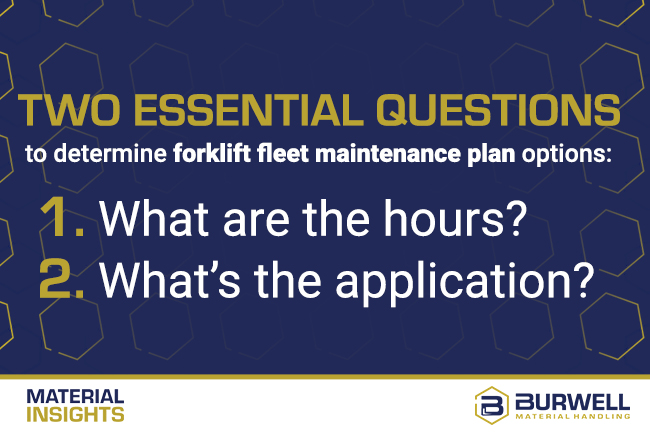
“Even two units that are exactly the same, two customers can use them for two totally different applications,” Milanes says. “They could require two totally different maintenance agreements or just maintenance cycles in general.”
He says you should consider:
- What are you moving with the forklift?
- How much are you going to use it?
- Are you going to be inside or outside while using the forklift?
- What type of environment is your facility?
- Freezer
- Smooth floor
- Clean
- Dirty
If you are unsure about the hours you’re going to put on your forklifts, Milanes says you can look back at previous purchases or leases and review the data from those to see how much on average you use your equipment.
You can also calculate forklift fleet utilization by shift:
Number of units x number of operators x number of shifts = Usage hours per day
Then multiply that number by week, month, and year.
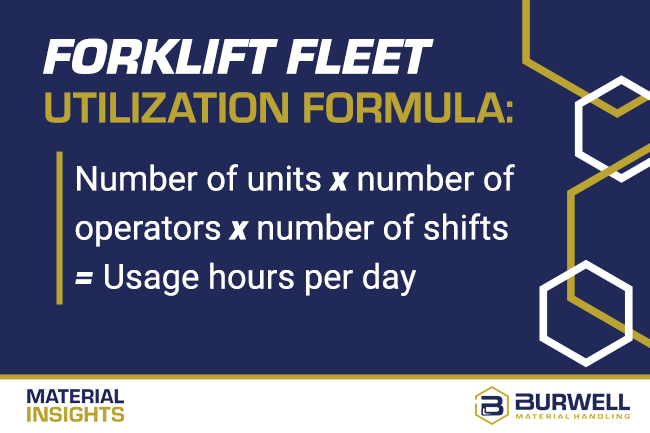
These details influence everything from service frequency to the type of coverage that makes the most sense.
Forklift Service Agreements: PM vs. Full Maintenance
There are two basic service agreement types for forklift fleet owners to choose between:
- Preventative Maintenance (PM): Scheduled services based on time or usage intervals
- Full Maintenance (FM): Includes PMs plus coverage for breakdowns, repairs, and often parts
“Everyone’s a candidate for full service,” Milanes says.
Think of a full maintenance agreement as an insurance policy for your fleet: predictable monthly costs and faster resolution when issues arise.
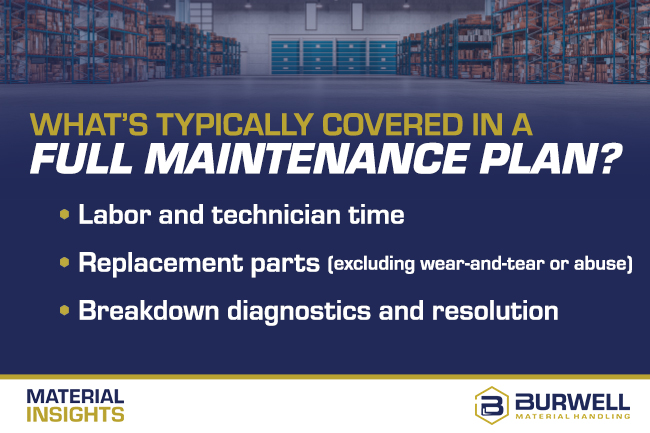
“Due to the investment that a customer makes on a monthly basis with a full maintenance plan, we’re also guaranteeing that your downtime is going to be very limited,” Milanes says. “If something’s wrong with the equipment, outside of negligence or abuse, we guarantee timely service response times and if needed, temporary replacement units while repairs are completed at no additional cost to the customer.”
What’s typically covered in a full maintenance plan?
- Labor and technician time
- Replacement parts (excluding wear-and-tear or abuse)
- Breakdown diagnostics and resolution
- Milanes says if you are considering a full maintenance plan, you also need to weigh:
- How long you plan to keep the equipment
- Whether that usage exceeds the OEM’s warranty coverage
“It doesn’t make a whole lot of sense for a customer to invest on a monthly basis if it’s going to be below the hour mark from a warranty perspective,” he says.
Why Telematics Belong in Your Forklift Maintenance Plan
Fleet management tools like Burwell Connect can also enhance your visibility into service needs.
“There’s a huge advantage with having telematics associated with your equipment,” Milanes says. “It helps you understand your investment and performance of each unit, keeps your operating environment safe and most importantly, prioritizes the safety of your workforce.”
Advanced telematics systems allow you to:
- Monitor usage in real time
- Schedule service based on actual wear
- Track trends across your entire fleet
Also, look for partners who can help you understand your forklift fleet data and feed you insights. Milanes says Burwell Material Handling has centralized monitoring through Burwell Connect, which will give customers real-time oversight and proactive technician dispatch.
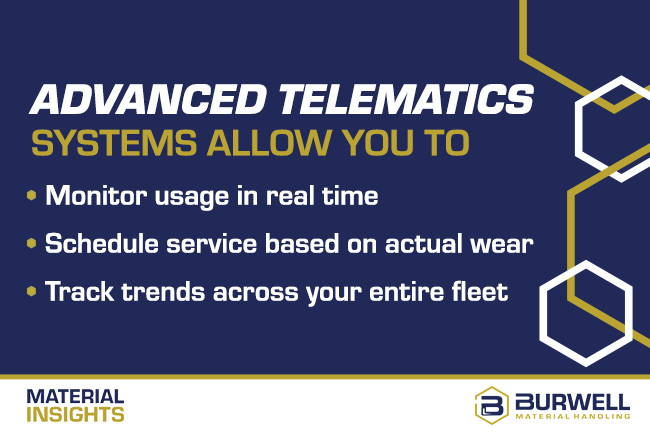
“What we really want to provide is a total solution for all material handling needs, that helps make fleet monitoring more hands-off for the customer so you can focus on what you do best,” he says.
In-House vs. Outsourced Maintenance: What You Need to Know
When deciding which forklift fleet maintenance plan to go with, you should also consider whether your operation has in-house service technicians and whether you are equipped to manage maintenance internally.
Milanes says this can work, if those teams are:
- OEM-trained
- Properly equipped
- Experienced across multiple product lines
“This equipment is so specialized, and it’s so unique — a Bobcat is different from a Clark, which is different from a Hyundai,” he says. “Even the ports and software are different.”

Self-service might seem like a cost-saver. But when a key unit goes down and internal techs are busy or underqualified, the delay can cost more than a service agreement would have.
“We always recommend that you have factory-trained or OEM-specific technicians to work on this equipment,” Milanes says.
Customizing Your Forklift Fleet Maintenance Plan
Ideally, service plans should be able to be tailored to your operational needs. Whether it’s a specific part (like batteries or clamps), a resident technician, or faster service intervals, Milanes says you should work with a service partner that is negotiable.
“As a service partner, our first answer is never ‘no,’” Milanes says. “Our first answer will be: ‘How do we provide you a solution?’”
Even within full maintenance, contracts can be customized by unit class, workload, location, or timeframe. One-size-fits-all isn’t going to cut it for most multi-location distribution or warehousing operations.
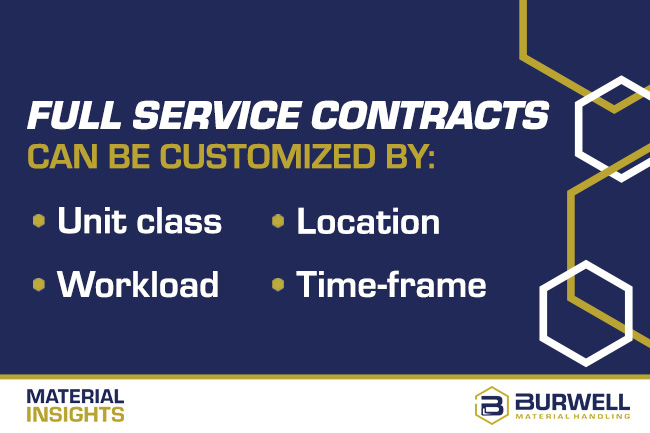
“Every maintenance agreement is different,” Milanes says. “Whether it’s a PM or full maintenance plan, there’s all sorts of options. Even within those agreements, you should be able to tailor it to exactly what you need.”
Safety is Top Priority of Regular Forklift Maintenance
While important, uptime should not be your only concern when it comes to your forklift fleet. You also need to make sure your forklifts are safe to operate for your team.
With a full maintenance plan for your 10 or more forklift trucks, you are building in additional safety checks where technicians can flag potential issues before they become an issue, Milanes says.
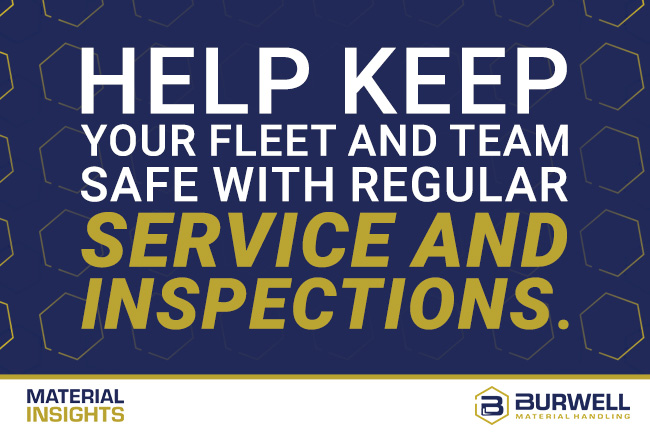
“When we go in there, our factory-trained technicians are inspecting your equipment and we’re not only looking at major components such as the hydraulics, brake system, and engine — we’re also making sure that it’s safe to operate and that the forks are still serviceable, that the chains are greased, that they’re not slacked,” he says. “Things that the untrained eye wouldn’t know to look for.”
These regular, added touchpoints by trained service experts help keep your team compliant, safe, and ahead of the game.
“Our technicians see this equipment every day,” Milanes says. “They know what to look for and have the ability and tooling to address them.”
Turn Forklift Maintenance Into a Competitive Advantage
If you’re acquiring multiple forklifts, you’re building the foundation of how your operation moves forward. The right service plan:
- Protects your uptime
- Controls your costs
- Enhances your safety
- Supports your growth
Ready to select the forklift fleet maintenance plan that’s right for you? Contact your Burwell Material Handling fleet specialist today to choose the service plan that meets your operation’s needs.
Frequently Asked Questions: Forklift Fleet Maintenance Plans
What is the best maintenance plan for a forklift fleet?
The right plan depends on how much you use your equipment and in what conditions. For larger, multi-unit fleets, a full maintenance agreement offers peace of mind with predictable costs, faster repairs, and fewer disruptions.
What’s the difference between preventative and full maintenance?
- Preventative Maintenance (PM): Regular, scheduled service (like inspections, oil changes, and filter swaps).
- Full Maintenance (FM): Includes all PM services plus coverage for breakdowns, parts, and labor — ideal for minimizing surprise expenses and downtime.
Why is telematics important in forklift maintenance?
Telematics gives you real-time data on usage, wear, and operator behavior. That means smarter scheduling, less unplanned downtime, and stronger ROI.
Can I use in-house technicians for forklift maintenance?
Yes, but only if they are OEM-trained, properly equipped, and experienced across your entire fleet. Otherwise, we recommend outsourcing to a certified dealer to prevent costly missteps.
Can I customize my maintenance plan?
You should absolutely find a service partner that can work with your specific needs. For example, Burwell Material Handling plans can be accommodated to include battery coverage, resident techs, faster service intervals, or attachment-specific guarantees. You shouldn’t need to be stuck with a cookie-cutter contract.
